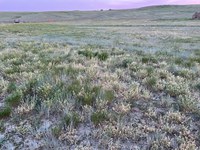Producers Have Options for Managing Drought-affected Alfalfa
(Click the image below to view a high-resolution image that can be downloaded)
Despite recent moisture in some areas, widespread drought conditions persist across North Dakota.
Reductions in forage production are expected to impact not only range and pasture, but these reductions also will reduce the potential of a hay crop by at least 50% in terms of biomass production this year.
“One of the most economically important hay crops that is impacted by drought is alfalfa,” says Janna Block, Extension livestock systems specialist at North Dakota State University’s Hettinger Research Extension Center. “Many North Dakota producers are evaluating their alfalfa stands and determining options for the best way to utilize available forage.”
Drought has different impacts on alfalfa than it does on grasses. With alfalfa, the leaf area is reduced, although not as much as stem growth. This means that the leaf-to-stem ratio can be higher in drought-affected alfalfa. As a result, alfalfa from drought-stressed fields may have improved forage quality in some cases, even though yield will be reduced.
Here are a few things producers need to consider when deciding whether to hay an alfalfa stand:
- Plant height - If an alfalfa stand is more than 12 to 14 inches tall and flowering, haying it probably is advantageous.
- Phenology - Alfalfa typically is harvested at the late bud or first flower stage. However, allowing alfalfa to reach at least 10% bloom before harvesting may be beneficial to enable plants to better handle drought stress. Because stem growth is more restricted than leaf growth during drought, some data indicate that delaying harvest will not result in the same quality reduction that it would during normal years.
- Percent of alfalfa in the stand - Mixed stands with less than 25% alfalfa may not have adequate biomass to hay due to drought impacts on cool-season tame grasses.
- The presence of alfalfa weevils - If the weevils are present, alfalfa may need to be cut even if is shorter than 12 inches as a method of weevil control. Insecticide application is possible, but if the plant already is drought-stressed, it won’t grow any taller.
“Grazing may be a good option for stands that do not meet the criteria for haying,” says Marisol Berti, professor of forage and biomass crop production in NDSU’s Plant Sciences Department. “Grazing fields that aren’t suitable for haying will help keep the plants in a vegetative state and increase the potential for regrowth. This may enable producers to harvest later in the season if they receive adequate moisture. Grazing alfalfa may help rejuvenate old stands by reducing grass and weed competition.”
Prior to grazing livestock, producers need to estimate the production of the alfalfa stand and set the appropriate stocking rate. A general rule of thumb is that 1 ton of standing alfalfa will produce about 50 animal-unit days (AUD) of grazing, assuming a 1,000-pound animal.
“The most accurate method to calculate forage production is the clip-and-weigh method,” says Miranda Meehan, Extension livestock environmental stewardship specialist. “This method requires the actual harvesting of standing forage at a given time to predict available forage.”
See NDSU Extension publication “NDSU Range and Forage Production Sample Kits” (https://tinyurl.com/237mbw4v) for detailed instructions on calculating forage production.
“Once forage production has been determined, then an adjustment must be made for harvest efficiency,” Meehan says. “Harvest efficiency is the amount of the plant that livestock will impact during the time they are grazing the pasture. Harvest efficiency is expressed as a percent and should be multiplied by the total amount of forage. The recommended harvest efficiency in this scenario would be 35%.”
If possible, using rotational grazing will increase the harvest efficiency and reduce the potential for negative impacts to the stand. Regardless of grazing method, a minimum stubble height of 4 to 6 inches should be maintained.
“Although producers can graze pure alfalfa stands, a mixture of alfalfa and grass will help reduce the risk of bloat,” Block says. “For pastures that have a high percentage of alfalfa (30% to 50% or more), it is best to wait to graze until alfalfa reaches the bud stage. The risk of bloat will decrease immensely as the stand reaches the 30% to 40% bloom stage; however, so will forage quality.”
Producers never should turn hungry livestock into alfalfa pastures. Provide a full feed of dry hay or grass pasture before grazing alfalfa. Experts also advise producers not to turn cattle out on alfalfa while rain is falling or if a heavy dew is present. Also, producers must observe animals closely the first several days of grazing to make sure they have no issues.
Dietary supplements such as poloxalene bloat-prevention blocks or ionophores also will help reduce the risk of bloat. Poloxalene should be provided several days prior to grazing alfalfa, and it should be available throughout the grazing period. Ionophores can be provided in mineral supplements or other commercial feeds.
Another strategy producers can consider is giving livestock free-choice access to grass hay while grazing alfalfa.
“Grazing may be a good option for managing drought-stressed alfalfa stands so producers are able to maximize forage production potential,” Block says. “It is important that grazing animals are managed properly to maintain the long-term health of the stand and reduce bloat risk to livestock.”
NDSU Agriculture Communication - June 15, 2021
Source: Janna Block, 701-567-4323, janna.block@ndsu.edu
Source: Miranda Meehan, 701-231-7683, miranda.meehan@ndsu.edu
Source: Marisol Berti, 701-231-6110, marisol.berti@ndsu.edu
Editor: Ellen Crawford, 701-231-5391, ellen.crawford@ndsu.edu


